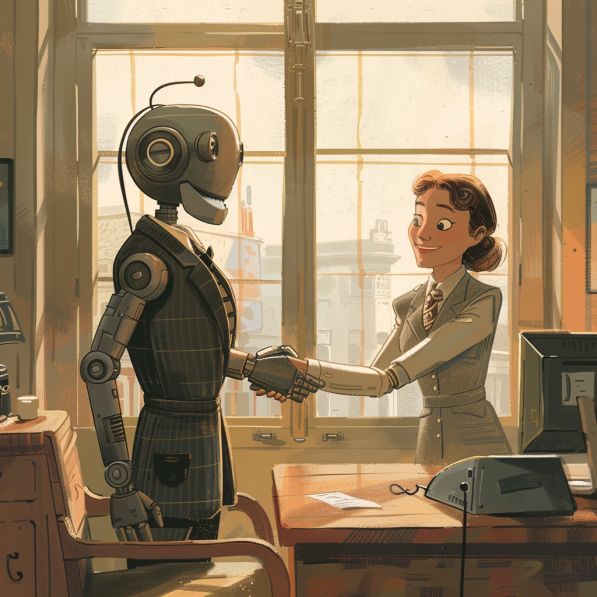
AI Advancements and Public Perception: A Conversation in a Real Estate Office
This past Tuesday afternoon when I found myself in the lobby of a local real estate office, waiting for an appointment. To pass the time, I struck up a conversation with a friend who happened to be there for a similar reason. Our chat quickly turned to the topic of AI (I know, shocker) when I decided to show her a new feature from the upcoming ChatGPT-5 release.
“Listen to this,” I said, holding up my phone. I played an audio clip of the AI speaking, its cadence eerily human-like, complete with natural pauses for breath. “It’s almost impossible to tell the difference from a real person, except for occasional lags caused by bad cell service,” I explained.
My friend’s reaction was immediate and intense. Her eyes widened, and I could see a mix of fascination and apprehension cross her face. “This is incredible,” she said, her voice tinged with worry, “but how will we know what’s real anymore? We’re all going to be manipulated by computers soon. Everything is changing so fast.”
Her response, while more pronounced, echoed a sentiment I’ve encountered numerous times when discussing AI advancements with people unfamiliar with the technology. It’s a common reaction – a blend of awe at the capabilities and fear of the unknown implications.
I’ve found that this apprehension often stems from a limited understanding of AI technology and its current state. Many people’s perceptions are shaped more by science fiction and sensationalized media reports than by the reality of AI’s capabilities and limitations.
“I understand your concern,” I said, trying to offer a balanced perspective. “But it’s important to remember that this technology, like any other, is a tool. It’s how we choose to use it that matters.”
I went on to explain that while AI voice synthesis technology has indeed made remarkable strides, it’s not inherently designed for deception. “Think about how this could be used to help people with speech impairments, or to create more natural-sounding audiobooks,” I suggested.
However, my friend remained skeptical. “But what about people using it for scams or spreading misinformation?” she asked, a valid concern in our age of digital information.
I nodded, acknowledging the legitimacy of her worry. “You’re right, there are potential risks. But that’s true for many technologies we use every day. The key is to develop safeguards and educate people about these advancements.”
As our conversation continued, I realized how this exchange in a mundane setting – a real estate office lobby – exemplified the broader societal reaction to AI advancements. It highlighted the gap between the rapid pace of technological progress and public understanding.
This disconnect poses a significant challenge. On one hand, AI has the potential to revolutionize numerous fields, from healthcare and scientific research to education and environmental conservation. On the other, if public fear and misunderstanding persist, it could lead to resistance against beneficial applications of AI or, worse, knee-jerk regulations that stifle innovation.
Addressing this challenge requires a multi-faceted approach:
- Improved Public Education: We need more accessible, jargon-free information about AI capabilities, limitations, and potential applications. This could be integrated into school curricula and public awareness campaigns.
- Responsible Reporting: Media outlets should strive for balanced, accurate reporting on AI advancements, avoiding sensationalism while still addressing legitimate concerns.
- Transparent Development: AI companies should be more open about their development processes and the intended applications of their technologies.
- Ethical Guidelines: The AI community should continue to develop and adhere to ethical guidelines for AI development and deployment.
- Public Dialogue: Creating more opportunities for public engagement with AI researchers and developers could help demystify the technology and address concerns directly.
As our appointment times approached and our conversation wound down, I could see that my friend was still processing the implications of what she’d heard. While her initial fear hadn’t completely dissipated, she seemed more curious than anxious.
“I guess I need to learn more about this stuff,” she said as we parted ways. “It’s not going away, is it?”
“No, it’s not,” I replied with a smile. “But understanding it better is the first step to ensuring it develops in a way that benefits all of us.”
This brief exchange in a real estate office lobby serves as a microcosm of the larger conversation society needs to have about AI. As AI continues to advance and integrate into our daily lives, fostering understanding and open dialogue will be crucial. Only then can we navigate the complex relationship between AI and the human condition, balancing innovation with ethical considerations and public concerns.
The future of AI isn’t just about technological capabilities; it’s about how we as a society choose to shape and use these powerful tools. By bridging the gap between AI advancements and public perception, we can work towards a future where AI enhances human potential rather than being perceived as a threat to it.


